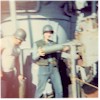

 |
 | ||||
| U.S.S. Allen M. Sumner DD-692 | |||||
| Main Battery | |||||
5 inch/38 caliber Mark 12 Dual Purpose Gun
Installed during construction and retained throughout her active service, Sumner deployed 6 5"/38 Mk 12 guns housed in three Mk 38 twin mounts with two forward and one aft. The after mount could actually fire forward of the ship! Ammunition was supplied from the magazines via the "ready service ammunition handling ring," also known as the "merry-go-round" which was located immediately below the mount. The guns could be aimed and fired either from automatic control or in manual mode. The mounts could be trained at a rate of 25 degrees per second and elevated from -15 degrees to 85 degrees at a rate of 15 degrees a second. They were capable of fire at any angle with an experienced crew able to sustain a 15 round per minute fire rate. This rate could rise to 22 rounds per minute at optimum loading angles. Range of this weapon was 18,200 yards with a ceiling of 37,200 feet. All of the following views are of the these guns as they appeared aboard the Sumner.
5"/38 Ammunition
Training
|
A practice 5"/38 loading machine was located on the Torpedo Deck where new hands learned the basics of feeding a 5"/38. |
||
 |
 |
 |
Fire Control
The guns in action
Many thanks to Charlie Blackburn, Glen Burdett, Al Payne, Arne Schumacher, Harold Jackson, Ralph Stamp, Gary Vogel, Eric Bollin, Richard Borutta, Dolphus Burton, Gary Carnot, Gary Jensen, Billy Johnson, Bob Misiano, Mike Raatjes, Doug Seal and Hank Lunki for sharing these images with us.